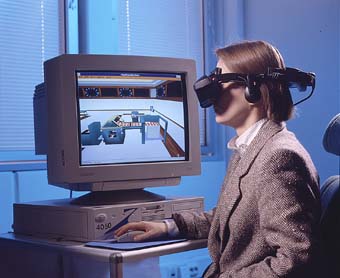Virtual Reality for Visualisation of Interior Decoration and Furnishing
by Matti Kuusisto and Raimo Launonen
A new research project VIRSISU has been launched in order to develop methods and tools for marketing support of furnishing and interior decoration utilising photo realistic virtual reality.
The opportunities of furnishing design are numerous because of different room layouts and because of both several furniture and material choices. It is very difficult to visualise different combinations and also it is almost impossible to confirm ergonomical and other design rules with traditional methods.
A realistic virtual reality space will supply an excellent solution for interior design and marketing.
After modelling a room or other space in 3D system it will be easy to test different surface materials and furnishing elements in order to find out visual impression, functionality or ergonomics. A traditional two dimensional image gives very limited possibilities to test different alternatives in a realistic space.
In addition to design and marketing of furnishing elements virtual reality system could be utilised in visualisation and marketing of the space itself - the piece of real estate or the rooms could be visualised with different realistic interior decorations and furnishing also before the building has been completely built.
However, the artificial virtual space is not usually capable to reproduce details, colours and surface textures with reasonable accuracy for effective utilisation in marketing purposes. If the system is used for furniture or tile marketing the colour of a sofa or the surface texture of a tile wall should not be very different compared to the real product.
The objective of the two years VIRSISU project is to develop and test new methods and tools for 3D virtual reality marketing support system of furnishing and interior decoration. The main areas will be integration of 3D modelling and colour management to virtual reality visualisation, because the modelling of 3D objects is still very laborious and besides not enough attention has been paid on the colour matching and colour calibration in low cost systems and not even in professional system.
In the project also a low cost pilot system will be developed. After the first project year the pilot system will be capable to demonstrate different possibilities with new 3D modelling and colour management features and after the second year the pilot will be suitable for tests in companies.
In addition new application and development areas for different techniques and methods will be surveyed and the goal is to start new product development projects based on research results.

The PostPressSIM learning simulator can be equiped with head mounted
stereo displays and 3D stereo sound is supported.
The VIRSISU project is a part of a national technology programme of Tekes Technology Development Centre Finland: Industrial Applications of Multimedia -programme 1996-1999. The technology programme consist in part of the public research projects of universities and research institutes like VIRSISU, and in part of confidential technology and product development projects of companies. In these cases the level of publicity of the programme is separately agreed upon with Tekes.
VTT Information Technology is the project manager and the main executing partner of this national project and VTT works in co-operation with Department of Interior Architecture and Furniture Design and Department of Fashion and Textile Design of University of Art and Design Helsinki UIAH. The industrial partners are Finnish companies from the areas of furnishing, painting colours, tiles and textiles.
Another virtual reality project at VTT has been introduced in ERCIM
News No. 28 January 1997: the EU-Leonardo project PostPressSim Computer
aided training system for book binding, finishing and mailing. The
PostPressSIM virtual reality simulation and multimedia system will be the
first software solution for educational needs of post-press operations
and machined in schools and companies. With the projected system different
groups could be trained to understand and use various production machines
of finishing and mailing departments. The first educational software modules
will be available for end-users November 1997 and a demonstration version
of the PostPressSIM software could be downloaded from
http://www.vtt.fi/tte/samba/projects/postpres.sim/index.htm.
Please contact:
Matti Kuusisto - VTT Information Technology
Tel: +358 9 4565948
E-mail: Matti.Kuusisto@vtt.fi
